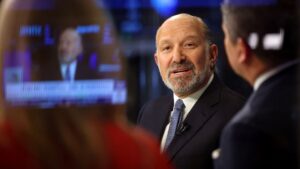By the end of Wednesday, the Dow Jones Index (US30) fell by 0.48%. The S&P 500 Index (US500) gained 0.30%. The Nasdaq (US100) Technology Index closed up 0.04%. The US stocks rose to new records on Wednesday, supported by lower inflation data and a strong Oracle report. The Producer Price Index for August fell by 0.1% against expectations of a 0.3% increase, the first monthly decline in four months. The annual Producer Price Index was 2.6%, below the expectations of 3.3%, which increased hopes that Thursday’s CPI report would confirm the disinflationary trend. The inflation surprise, combined with soft labor market data, fueled bets that the Fed could cut rates by 50 basis points next week instead of the expected quarter-point change.
Oracle shares surged 39% after the company announced a sharp increase in cloud service orders, driven by demand for artificial intelligence. The company’s value increased by $85 billion in a single day, a new record. Nvidia (+3.8%) and AMD (+2.4%) shares rose, while Apple shares fell by 3.2% after the launch of the new iPhone 17 was underwhelming.
European stock markets traded mixed on Wednesday. The German DAX (DE40) fell by 0.36%, the French CAC 40 (FR40) closed up 0.15%, the Spanish IBEX35 (ES35) gained 1.29%, and the British FTSE 100 (UK100) closed down 0.19%. The ECB is expected to leave borrowing costs unchanged today, although updates to economic expectations and guidance on the policy outlook will be closely watched. Geopolitical risks also remained in focus, with Israel striking Hamas targets in Qatar and Poland intercepting drones that entered its airspace during a Russian attack on Ukraine.
Annual inflation in Norway for August 2025 rose to 3.5%, the highest since February, compared to 3.3% in July and in line with expectations. On a monthly basis, the CPI fell by 0.6%, the first decline since March, offsetting the 0.8% increase in July, which was also in line with projections.
WTI crude oil prices rose more than 1.5% on Wednesday to $63.7 per barrel, posting a third consecutive gain as traders balanced geopolitics and economic signals. The momentum accelerated when President Trump questioned the Russian drone invasion of Polish airspace on social media, triggering short-covering amid speculation that he might soon impose sanctions on Russian energy exports. This followed reports that Trump had urged the EU to join him in imposing tariffs on China and India, major buyers of Russian oil, to force Moscow to the negotiating table. Additionally, Israel’s strike on Hamas leaders in Qatar reignited Middle East tensions and added a geopolitical risk premium. However, the gains were capped as US government data showed a larger-than-expected increase in crude oil inventories of 3.9 million barrels.
Asian markets were mostly higher yesterday. The Japanese Nikkei 225 (JP225) rose by 0.87%, the Chinese FTSE China A50 (CHA50) jumped 0.48%, the Hong Kong Hang Seng (HK50) gained 1.01%, and the Australian ASX 200 (AU200) showed a positive result of 0.31%.
The Hang Seng Index rose to a four-year high on broad-based gains. In China, the sharpest drop in the Consumer Price Index in six months in August rekindled hopes for new government support, which could lead to an increase in consumer prices, while producer deflation hit a four-month low as Beijing’s efforts to curb corporate price wars were successful. Following a bilateral currency swap deal between China and Europe, shares in the real estate and financial sectors rose. Technology stocks also climbed, fueled by optimism about AI earnings after strong results from Oracle in the US. Alibaba rose by 0.6% on the optimistic outlook, and Baidu HK gained 2.6% after unveiling an updated artificial intelligence model.
The Australian dollar rose to around $0.662 on Thursday, nearing its highest level since early last November, driven by an improved risk appetite amid growing bets on a Fed rate cut. The commodity-linked Australian dollar also continued to benefit from rising oil and gold prices as escalating geopolitical risks fueled demand for safe-haven assets. Looking ahead, today’s speech by an RBA official will be closely monitored for further policy signals, as markets have generally priced in a 25 basis point cut in November.
New Zealand Central Bank chief Christian Hawkesby said on Thursday that the future path of the official cash rate (OCR) would depend on the pace of the economic recovery. The main prognoses for the OCR suggests a cut to around 2.50% by the end of the year. In August, the RBNZ lowered the OCR to a three-year low of 3.00% and signaled that it would continue to ease the rate as domestic and global factors constrain growth.









